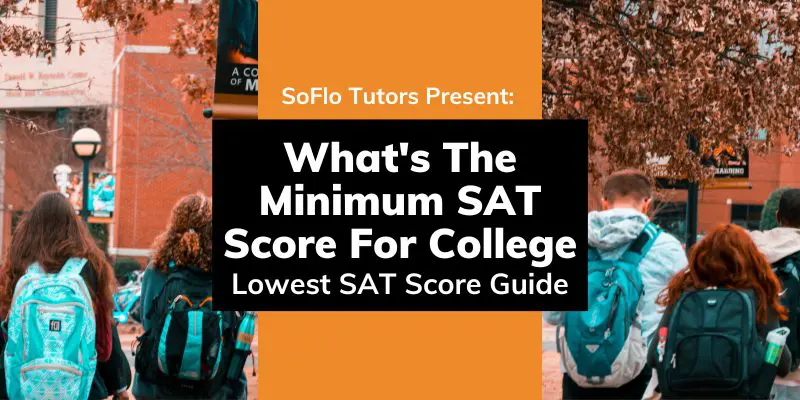
When applying for colleges, there are many components to the application that you have to take care of – GPA, extracurriculars, personal statement and essays, and, lastly, standardized testing. Many students dread taking the SAT and are worried about the score they have to get to receive an offer of admission into a college. While the SAT can be an intimidating test to take, students who adequately prepare for it do well, reach their target scores, and get into their top-choice schools. It is always good, however, to consider the worst-case scenarios.
What happens if you don’t perform your best on the SAT? What is the lowest score you can get? What is the minimum score you should aim for to be successful in college admissions? What should you do if you get a low SAT score? Read on to find out the answers to these questions.
One important thing to note is that your SAT score is, by far, not the determining factor of your application. As mentioned before, colleges consider many aspects of your educational career when reviewing your application, and the SAT is just one component of that. While you want to avoid a low SAT score, remember that it is not the end of the world if you do not do your best the first time and that there is always room for improvement!
What’s The Lowest SAT Score That You Can Get?
To address the worst case scenario: What even is the lowest possible score you can get on the SAT? The answer is: 400. The next section will explain what this score means and how the SAT is graded.
More importantly, you may wonder if it is even possible to get this score? It is highly unlikely, bordering on impossible. To get this score, you will have gotten every single question on the SAT wrong. While some SAT questions are tricky and difficult (on purpose), there are also plenty of questions that test extremely basic concepts you would’ve learned in elementary school. For example, in the Math section, there are challenging geometry and word problems, but you can also find simple arithmetic (addition, subtraction, division, and multiplication) and logic problems that really just use common sense.
If you’re still worried about getting this score on the test, think about this hypothetical: If a monkey took the SAT and answered the questions at random, on average, he would still get around 25% of the questions right. This is because the majority of the questions on the test are multiple choice with four answer options (there are 13 grid-in questions in the Math section). On each question, you have a one in four, or 25%, chance in choosing the correct answer. Therefore, even a monkey wouldn’t get the lowest SAT score of 400.
The only practical way for a student to get a 400 on the SAT is to submit the test without having filled out a single question. So, make sure you don’t fall asleep throughout the whole test! With this in mind, you can start preparing for the SAT with the peace of mind that you won’t get the lowest possible score – and, most likely, no where near that score! In fact, the average SAT score for the class of 2020 was a 1051 – more than double the lowest score. The average Math score for the SAT in the class of 2020 was 523, and the average Evidence-Based Reading and Writing (EBRW) score for the class of 2020 was 528.
SAT Scores Explained
The SAT is graded on a numerical scale ranging from 400 to 1600. The score is the sum of two section scores, Math and EBRW. The section scores range between 200 and 800. Therefore, if you got the lowest score on both sections (200), your score would be 400, the lowest total score you can get on the SAT.
What About Percentiles?
Your SAT score is graded on a numerical range, but one way you can interpret it is based on percentiles. Percentiles can often matter more than the raw score itself, so it’s important to also learn about the lower end of percentile rankings.
If you don’t know what percentile means, you can check out this article explaining the concept in-depth. For a quick explanation, when you receive your SAT score, you also receive a percentile ranking. This basically tells you how well you did compared to other students who took the same test. Because a raw SAT score is subjective to whether it is “good” or “bad,” percentiles provide a measure on whether your score is good or bad, compared to other students.
Percentiles range from 1 to 99. If you got the 99th percentile, it means your score is in the top 1% of test takers. In other words, your score is higher than 99% of other students who took the test. If you got a score in the 50th percentile, that means you got the median score of all test takers. And if you got a score in the 1st percentile, you are in the bottom 1% of test takers. Your score may not have been a 400, but it is one of the lowest scores received among your peers.
What’s The Minimum SAT Score You Can Have And Still Get Into College?
Now that you know the lowest SAT score (and percentile ranking) you can possibly get, you might ask what the minimum score is to get into college. This answer is not so straightforward. The minimum SAT score you need depends on the colleges you are applying to. Colleges differ in their admissions requirements and how selective they are. Some of the most selective schools accept students with average scores in the 1500s, while many great schools accept students with scores in the 1300s.
It is up to you to determine which schools are compatible with your goals and feasible with your grades and extracurricular performance, and then aim to get an SAT score that matches their admitted student pool. Every year, most colleges publish a report on statistics about their most recent admitted class, including their SAT scores. Colleges will sometimes post the median score (50th percentile), and sometimes will post the 25th and 75th percentile scores as well. This is to give you a comprehensive idea of the range of SAT scores of students that were accepted by the college. Here is an example of SAT scores that a college could provide on their website. They could provide a range with the middle 50% of scores, and we’ve filled in what would then be considered a “low” and “high” score accordingly.
| Low Score | Middle 50% | High Score |
| 980 | 990-1190 | 1240 |
| 1120 | 1130 – 1260 | 1310 |
| 1190 | 1200-1360 | 1410 |
| 1290 | 1300-1430 | 1480 |
| 1310 | 1320-1470 | 1520 |
| 1360 | 1370-1520 | 1570 |
| 1390 | 1400-1580 | 1600 |
| 1420 | 1430-1590 | 1600 |
Generally, you should aim to get a score in the middle 50% or higher to increase your chances of getting admitted. Even though the 25th percentile scores show that students who got lower scores still got admitted, there are many other factors that could explain their situation. Maybe they’re a world-class trombonist, a sports recruit, or even a legacy admit. There are many factors that go into an application, but just to be safe, you should aim to have your SAT score be an asset, not a liability, to your application.
That being said, if you don’t hit that average score, do not entirely cross that school off your list. There is still a chance of admittance, as long as other portions of your application are strong and stand out. As mentioned before, though, while schools will not set a hard cut-off or minimum SAT score you have to get in order to apply, you want to be within a few points of the average to stay competitive.
Picking Schools To Apply To Based On Your Scores
Schools take into account many factors in your application, but you can get a general sense of which schools are a good match for you (and which ones you’re likely to get admitted to) based on your SAT score. When applying to college, you want to categorize potential schools into three categories: safety schools, match schools, and reach schools.
- Safety schools are ones where you are fairly certain you can get into, in other words, you pretty much have them on lock. In terms of the SAT, you score well beyond the middle 50% of SAT scores of their admitted students.
- Match schools are ones where you are somewhat confident you can get into. Your score lands around the 50th percentile SAT score of their admitted students, so your test scores match the average student they admit. In this case, other parts of your application, like your grades and extracurriculars, are likely to tip the case in your favor.
- Reach schools are ones that are unlikely for you to get into based on your SAT score. Your score is below the middle 50% of SAT scores of their admitted students. While it is unlikely, it isn’t hopeless. If you have a big “spike” – an extraordinary talent or accomplishment – schools can overlook a lower SAT score.
Note that selective schools like Harvard and Stanford are considered Reach schools to everyone – including students that match or exceed the school’s average published score. Admission is so competitive for these schools that a great SAT score doesn’t guarantee anyone an offer.
To help illustrate this process, here is an example situation we can go through.
Isabelle received a 1400 on her SAT. She is categorizing the colleges she’s applying to into “safety,” “match,” and “reach” schools based on her score. This is her thought process for each college:
- The University of Pennsylvania: Far Reach
Admitted student middle 50th percentile score range: 1510 – 1560.
Isabelle’s score is more than 100 points the median score range, so this school would be a reach for her. She shouldn’t completely scratch off the school from her list though – her extracurriculars, grades, and recommendations could bolster her application to make up for the lower score. The University of Pennsylvania is a far reach, however, because of its historically low acceptance rate and reputation, where even students with perfect SAT scores end up without an offer of admission.
- Villanova University: Reach
Admitted student middle 50th percentile score range: 1450 – 1520
Villanova is still a reach for Isabelle because her score is a little below the school’s 50th percentile SAT score range. Again, this school is still not out of the question for Isabelle, though, as other parts of her application might make her stand out. Her score remains in the bottom 25% of admitted students, however.
- Trinity University: Good Match
Admitted student middle 50th percentile score range: 1350 – 1480
With a score of 1400, Isabelle’s score is right in the middle of the middle 50% for Trinity University. This places her on par with other applicants, and considering her other qualifications are also strong, the school is a good match for her.
- Baylor University: Strong Match
Admitted student middle 50th percentile score range: 1170 – 1360
While Isabelle’s score is a little above the 50th percentile range at Baylor, her score is still not high enough to consider it a safety. This school, however, would still be a strong match for Isabelle as she would be a very competitive applicant considering her score places her in a high percentile among applicants.
- Towson University: Safety
Admitted student middle 50th percentile score range: 1060 – 1220
Towson University would be a safety for Isabelle because her score is well above – 180 points – the middle 50% range. This positions her in the top percentile of applicants to Towson, and considering her other qualifications are strong like her SAT score, she can fairly confidently count on this school to offer her a seat.
You should also consider the many other factors of the application when categorizing your schools as reach, match, or safety. Other statistics that colleges publish that you can look for are class rank and GPA. If your SAT score is towards the lower end of the middle 50%, but your class rank and GPA exceeds the admitted students’ average, the school could possibly be a match rather than a reach.
Schools are also somewhat placing less importance on SAT scores and focusing more on class rank and GPA because the latter are long-term indicators of academic performance (rather than a test you take a one or a few times your junior year). As mentioned many times, as well, college admissions pay special attention to special interests and extra-curriculars, which could give an applicant with a lower SAT score an extra edge. So take your SAT score with a grain of salt as an indicator of which colleges you’ll get into.
Setting Your SAT Target Score
Many high school students approach college applications with their dream schools in mind. They have a list of schools, but haven’t taken the SAT yet, rather than the other way around. This way, they can take the SAT knowing what score they have for a goal. But how should they set their goal score?
A great way to set your goal score is to focus on the 75th percentile score of the school that has the highest middle 50% score range. Meaning, if you aim for this score and reach it, you’re in a strong position to apply to all the schools on your list. If you fall a bit short, your score will still capture a lot of the schools on your list that have a lower 50% score range. Better safe than sorry!
Lets go through the process of setting a target SAT score with an example. Say Stella has a list of schools she’s applying to – a mix of her dream schools and other schools she thinks she has a good shot at getting in. The list is as follows:
- Tufts University
- UMass Amherst
- Wesleyan University
- Wheaton College
- Northeastern University
Her next step is to find the SAT score ranges each college reports on their admitted students. She can make a table with all the schools and their respective score ranges to be organized. Her table will look something like this:
| School | SAT 25th Percentile | SAT 50th percentile | SAT 75th percentile |
| Tufts University | 1470 | 1515 | 1560 |
| UMass Amherst | 1280 | 1365 | 1450 |
| Wesleyan University | 1480 | 1520 | 1560 |
| Wheaton College | 1260 | 1350 | 1440 |
| Massachusetts Institute of Technology | 1520 | 1550 | 1580 |
Based on her list of schools and their respective statistics, Stella’s goal score would be 1580. This is because MIT is the school with the highest range of middle 50% SAT scores on her list, and their 75th percentile SAT score is a 1580. Getting a 1580 on the SAT is a high goal, but even if Stella falls a bit short and earns a 1550 or even a 1520, she should be well-poised to apply to all the other schools on her list. In fact, the average 75th percentile score among all five schools on her list is a 1518.
What To Do When Your Score Is Not High Enough
What happens if you have a list of schools to apply to, take the SAT, but your score falls way below your target score? Don’t panic or feel too down – it happens more often than you think. The good news is that a low SAT score will not completely destroy your chances at attending college! The SAT is a test that depends all about your mindset and preparation, and there are several options and routes you can take if you are in this situation.
Retake The SAT
Retaking the SAT is always an option, considering you have enough time before the application deadline to submit your score. Maybe you didn’t have enough time before taking your previous SAT, or you studied the wrong way. This time, you can correct your preparation strategy and retake the test better prepared than ever. Some students also turn to tutors to help them reach their target score, as they can get personalized advice and a tailored study plan to keep them accountable. If you’re worried about colleges seeing how many times you’re retaking the SAT, check out this article.
Try Taking ACT
If the SAT is just not clicking with you, try taking the ACT. The style of questions and sections sometimes works better for students. Take an ACT practice test and see how you score. Most colleges take both the SAT and ACT, and neither is preferred over the other.
Apply To Test-Optional Schools
Many colleges are now going test-optional, meaning that it’s not required to send in a standardized test score with your application. If you are done taking the SAT, but your score does more to hurt than help your application, you can tailor your college list so that it contains all test-optional schools. Thus, you wouldn’t have to submit your SAT score and the strength of your application can just rely on your class rank/GPA/etc.
Re-Evaluate Your College List
Looking over your college list again and asking yourself if the schools on it are truly feasible is another option to consider if your SAT score is lower than you expected. As said previously, a bad SAT score does not automatically disqualify you from schools that are considered a “Reach,” but maybe it would be more pragmatic to add more schools in the “Match” and “Safety” categories of your list. Find schools that have their middle 50% of SAT scores within range of yours and consider applying to them as well.
Frequently Asked Questions
What Is The Minimum SAT Score For College?
There is no minimum SAT scores to apply to colleges. Colleges do not set cut-off or minimum scores you need to have in order to apply. Colleges do expect a certain score level from applicants, though, depending on their selectivity – the most selective colleges can expect an SAT score in the 1500s. Check out the average scores of recently admitted students in the colleges you are applying to (most colleges post these on their websites), and try to have your target score to reach or exceed these averages.
What Score Do You Need To Pass The SAT?
Unlike in high school, there is no “passing” or “failing” SAT score. Your SAT raw score can be interpreted in multiple ways, and a “good” SAT score can be subjective to each student. One measure of a good SAT score is its associated percentile ranking. Generally, it is good to have a ranking above 50%, as that means your score is higher than half of all the students that took the test. Specifically, the strength of your SAT score for college applications all depends what colleges you’re applying to and their average admitted student score.
What Is The Lowest SAT Score You Can Get?
Since the SAT is graded on a scale of 400 to 600, the lowest SAT score you can get is a 400. It is highly unlikely to impossible to get this score, however, as you would need to leave the entire test blank or get every single question wrong.
Get Your Target Score Easily With SoFlo Tutors
Make sure you reach your target score by working with SoFlo Tutors. All of our tutors attend top universities around the nation and scored in the 99th percentile on their SAT. They will work one-on-one on you to identify and improve your weak areas and increase your chances of getting your target score. Our tutors schedule to sessions to your availability and our costs start at $60/hour. Check out our tutoring services to book a session!
About The Author

Andie Pinga is an expert SoFlo tutor and a senior at the University of Pennsylvania double-majoring in Economics and Anthropology. She scored a 35 on her ACT, and when she’s not studying on campus or hanging out with friends, Andie enjoys rock climbing and playing the guitar.










